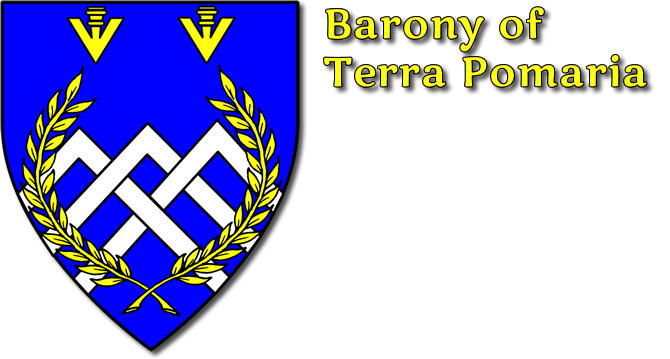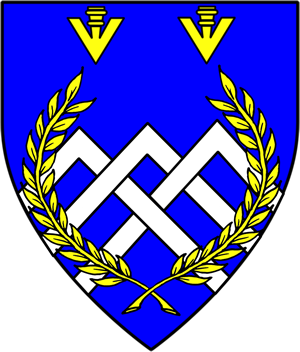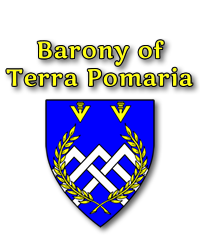18 Oct Hippocras
Then Serve It Forth…
By Lady Rosemary Willowwood de Ste. Anne
A bounteous harvest is coming in and the season of feasting is upon us. Feasting means parties, and parties mean special foods and drinks, as much as the budget of the household would allow. A favorite postprandial tipple during most of the middle ages was a sweetened spiced wine called “hippocras”. This concoction was named for the healer Hippocrates, the Greek physician known as “the father of medicine”, and was deemed a great aid to quiet digestion.
“Hippocras”
From Le Menagier de Paris [The Goodman of Paris], c. 1393
Translation by Power and Colton
HIPPOCRAS. To make powdered hippocras, take a quarter-of very fine cinnamon, selected by tasting it, and half a quarter of fine flour of cinnamon, an ounce of selected meche ginger fine and white, and an ounce of grains of paradise, a sixth of an ounce of nutmeg and galingale together, and bray them all together. And when you want to make your hippocras, take a good half-ounce of this powder and two quarters of sugar, and mix them together, and a quart of wine by Paris measure. And note that the powder and the sugar mixed together is [hight] “the Duke’s powder”.
To make a quart or a quarter-ounce of hippocras by the measure of Beziers, Carcassonne, or Montpelier, take five drams of fine cinnamon, selected and peeled; white ginger selected and peeled, three drams; of cloves, cardamom, mace, galingale, nutmeg, nard, altogether a dram and a quarter, most of the first, and less of each of the others in order. Let a powder be made thereof, and with it put a pound and half a quarter, (by the heavy measure), of lump sugar brayed and mingled with the aforesaid spices; and let wine and sugar be set and melted on a dish on the fire, and mix therewith: then put in the strainer, and strain until it runs a clear red. Note, that the cinnamon and the sugar should predominate.
TRANSLATION: (Since the original was in French, the translation has already been done.. Please check the glossary for additional information and textual comments.)
REALIZATION: This powder is fairly close to the mixture we use for mulled wine today. The measurements in the original recipe are deemed by various experts to be in ounces, but as long as the proportion is maintained, you can use bulk measure as well. Start with about ½ T. stick cinnamon, ½ t. ground cinnamon, about ½ t. total of mixed nutmeg and galingale or dried ginger. If you cannot find grains of paradise, add a couple of cracked black peppercorn and a few seeds (not whole pods) of cardamom. Add to about 1T. granulated sugar, and grind finely in a mortar. Mixed to this point, the powder is called “Duke’s Powder” (see glossary for confusing details.)
The second mixture is for a more complex hippocras. Mix about five parts(about ½ tsp. each) cinnamon, three parts ginger, about 1½ parts of a mixture of cloves, cardamom, mace, galingale and nutmeg. The mixture should be compounded so that there is less cardamom than cloves, less mace than cardamom, and so on down the line. Finely grind the spices in a mortar. Add to about a cup of sugar, and blend well. Mix the whole amount of spices and sugar with a quart of wine; our 750 ml bottles will require about ¾ of the mixture. Heat just until the sugar is melted, strain through filter paper or fine muslin, and serve warm or cold in SMALL amounts. This was a pleasant medicinal dose, not a joyous alcoholic libation.
For those who do not do “value-added” grape juice, there are a number of dealcoholized wines that would work just as well. Or use cider as a base; the tonic is in the spices, not the wine.
GLOSSARY:
About the Menagier: The Goodman of Paris was written in about 1393, as a guide to a young wife; only one section of the whole compilation is on cooking. The book was modeled on another recipe set known as Le Viandier de Taillevent”, written in about 1375 by a gentleman who was chef (or at least on the kitchen staff) to Charles IV, Charles V, and Charles VI of France. The books contain an almost identical collection of recipes; however, the Menagier, being an instructional manual, contains much more about supplying a kitchen. A king would, of course, have other people to take care of such trifles.
Meche ginger: Also called Mecca Ginger. The Viandier calls it gingenbre de mesche. There were many varieties of ginger current in the middle ages, usually based on quality.
Dram: A weight measure, in cooking measured as one-sixteenth of an ounce. It’s about the same weight as a pre-1980 penny. Modern pennies weigh about one-fourth less.
To bray: to grind in a mortar.
Measure of Beziers, Carcassonne, or Montpelier: These three cities are in the region of France known as Languedoc (Also called Midi), on the west side of the Rhone River from Provence. The pound in use in the Midi only had thirteen ounces, instead of sixteen; the author at the beginning of this paragraph having adopted the Beziers measure, says that here he means the pound in use in Paris (“… the heavier measure”). Isn’t standardization a relief?
Duke’s Powder: Standard spelling causes a problem here as well. A number of translators identify this as “poudre douce” or sweet powder, which is another common medieval seasoning. Say, “Thank you, Noah Webster!”
Nard: There are again a number of things this ingredient could be. In the early middle ages, this ingredient usually referred to a spice brought from India. There are a number of European and American substitutes for this ingredient, all probably different (and inferior) in taste from the original. It is such a minor ingredient, I suggest that you omit it here.
Grains of paradise: Seeds of Afromomum melegueta. Also called “Melegueta pepper” or “guinea grains”, it is a sharp spice similar, but unrelated to, cardamom. I recommend searching for these, if you want a quest; they are out there, but not easy to find. You can use about 2/3 pepper and 1/3 cardamom, for a very inadequate substitute.
Galingale: A rhizome similar to ginger (Alpinia galanga or Alpinia officinarum). Dried galingale can be found in Indian or Chinese markets. The former, also called greater galingale, is used mostly for cooking. The latter, lesser galingale, is used in oriental medicine. In the small amounts used here, either will serve.



